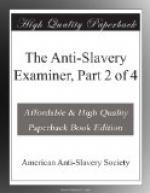“If Messrs. Kimball and Thome are not engaged Tuesday next, the Lieut. Governor will be happy to see them at dinner, at six o’clock, when he will endeavor to facilitate their philanthropic inquiries, by inviting two or three proprietors to met them.”
“Government House, St. John’s, Dec. 18th, 1836.” ]
The conversation on the subject of emancipation served to show that the prevailing sentiment was decidedly favorable to the free system. Col. Jarvis, who is the proprietor of three estates, said that he was in England at the time the bill for immediate emancipation passed the legislature. Had he been in the island he should have opposed it; but now he was glad it had prevailed. The evil consequences which he apprehended had not been realized, and he was now confident that they never would be.
As to prejudice against the black and colored people, all thought it was rapidly decreasing—indeed, they could scarcely say there was now any such thing. To be sure, there was an aversion among the higher classes of the whites, and especially among females, to associating in parties with colored people; but it was not on account of their color, but chiefly because of their illegitimacy. This was to us a new source of prejudice: but subsequent information fully explained its bearings. The whites of the West Indies are themselves the authors of that illegitimacy, out of which their aversion springs. It is not to be wondered at that they should be unwilling to invite the colored people to their social parties, seeing they might not unfrequently be subjected to the embarrassment of introducing to their white wives a colored mistress or an illegitimate daughter. This also explains the special prejudice which the ladies of the higher classes feel toward those among whom are their guilty rivals in a husband’s affections, and those whose every feature tells the story of a husband’s unfaithfulness!
A few days after our dinner with the governor and his friends, we took breakfast, by invitation, with Mr. Watkins, the colored planter whom we had the pleasure of meeting at Millar’s, on a previous occasion. Mr. W. politely sent in his chaise for us, a distance of five miles, At an early hour we reached Donovan’s, the estate of which he is manager. We found the sugar works in active operation: the broad wings of the windmill were wheeling their stately revolutions, and the smoke was issuing in dense volumes from the chimney of the boiling house. Some of the negroes were employed in carrying cane to the mill, others in carrying away the trash or megass, as the cane is called after the juice is expressed from it. Others, chiefly the old men and women, were tearing the megass apart, and strewing it on the ground to dry. It is the only fuel used for boiling the sugar.
On entering the house we found three planters whom Mr. W. had invited to breakfast with us. The meeting of a number of intelligent practical planters afforded a good opportunity for comparing their views. On all the main points, touching the working of freedom, there was a strong coincidence.




